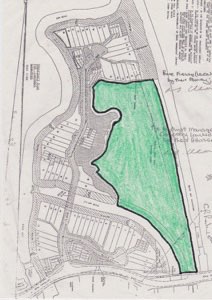The Landings Wood


Landings Wood. The woodland is healthy and growing vigorously. Between late April and the end of June I made a mammal survey in them, which I’ve done for several years for the London-based People’s Trust for Endangered Species — the survey area must be within 100 metres of dwellings/offices/light industry. I noted plenty of badgers and their signs, of course, and several resident squirrels, mice and lots of signs thereof, voles, and many bats in the evenings taking advantage of the insect life. In the past, there has been a fox in the woodland; and, incidentally, we know that there are four Muntjac deer living in the Lammas Lands across the Navigation.
There is a healthy bird population among the trees — helped by the coppicing done shortly after we acquired the land and further by our February work-party. Coppicing and thinning bushes out the tress, providing secure spring nesting. Breeding birds include blackbirds, chiff-chaffs, green and greater spotted woodpeckers, thrushes, siskins, green and gold finches, jays, nut hatches, great-, blue- and long-tailed tits, robins, pied and grey wagtails, and of course crows, magpies and pigeons.
As volunteer River Searchers for Surrey Wildlife Trust Anne and I have done winter, spring and summer surveys of the Wey on our assigned stretch around our estate and of the Landings Wood Stream through ‘The Basin’ (and,as part of ‘our patch’, of Hell Ditch between Catteshall Road and Bridge Street). We noted encouraging ‘riffles’ in the Wey, Hell Ditch and the stream, but also the deposition of several sand side-bars and silting up of some of the drains/culverts. The winter floods also spread Himalayan balsam — an invasive non-native species — along the banks of the weir run behind Waterside Close up to Catteshall Lock Bridge. Anne and I pulled much of it out, crushing and piling it up to provide warm nesting patches for grass snakes.
We have cleared much of the stream, raking back plant growth encroaching on the banks and pulling up water plants from the streambed itself; also clearing numerous cut-sapling logs and other debris from the stream. This has encouraged stronger flow, creating riffles and eroding some of the accumulated sand. We noted lots of damsel- and dragonflies, and other insect life, and spotted small fish too. Let’s hope theelopments will bring back the kingfishers!
Finally, as well as healthy trees, brambles, grasses and marsh plants, in spring we had a magnificent show of King Cups (Marsh Marigolds) down in the Basin.
It is a pleasure to know that we can now protect this super 3.5 acres of woodland for our enjoyment.
— David M. Jones, 41 BW